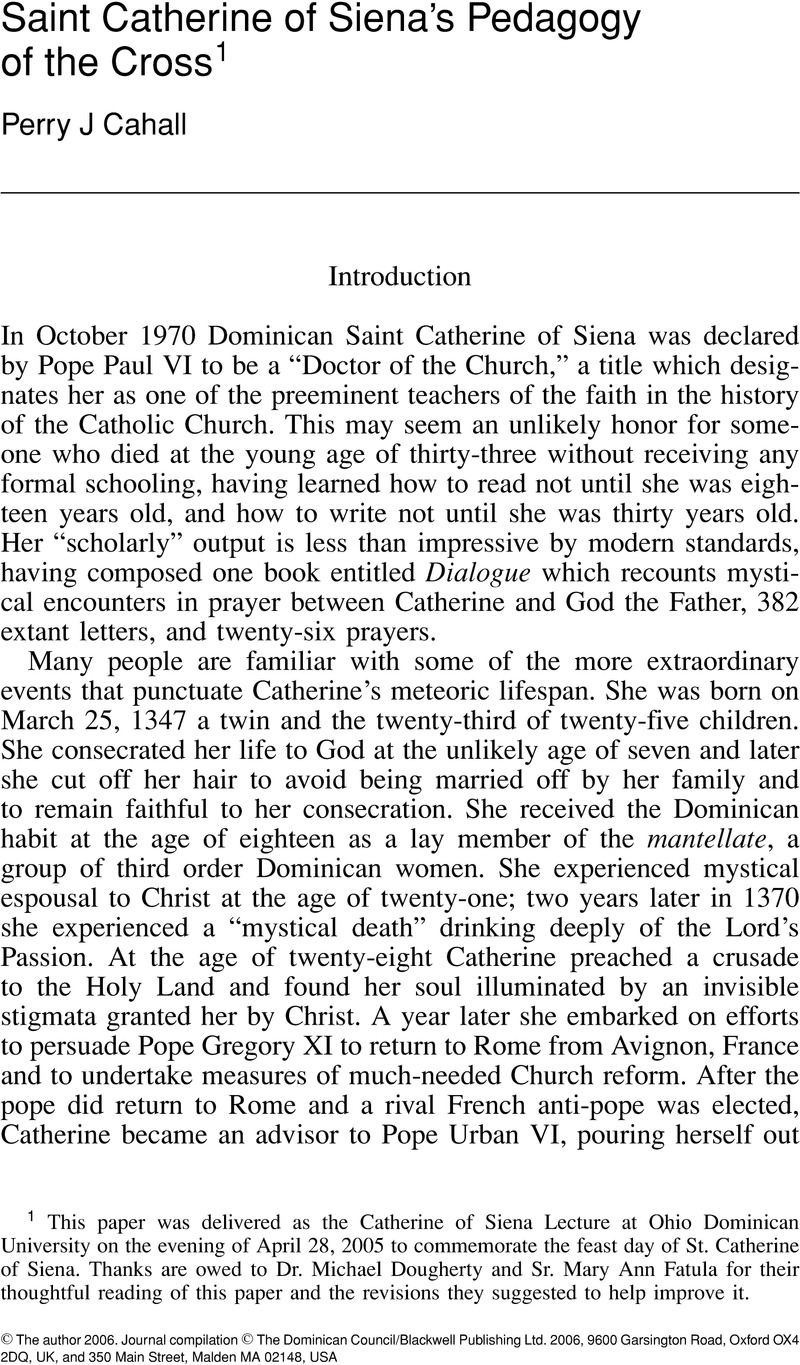Published online by Cambridge University Press: 01 January 2024

This paper was delivered as the Catherine of Siena Lecture at Ohio Dominican University on the evening of April 28, 2005 to commemorate the feast day of St. Catherine of Siena. Thanks are owed to Dr. Michael Dougherty and Sr. Mary Ann Fatula for their thoughtful reading of this paper and the revisions they suggested to help improve it.
2 O'Driscoll, Mary, “Introduction,”Catherine of Siena: Passion for the Truth, Compassion for Humanity – selected spiritual writings (New York: New City Press, 1993) 11Google Scholar.
3 Paul, Pope VI, “Catherine of Siena: The Gift of Wisdom,”The Pope Speaks 15 (1970): 198Google Scholar.
4 Ibid., 200.
5 Ibid.
6 O'Driscoll, 13.
7 Fatula, Mary Ann O.P., Catherine of Siena's Way. revised ed. The Way of the Christian Mystics 4 (Collegeville, MN: Liturgical Press, 1990), 108Google Scholar. I can suggest no better summary of Saint Catherine of Siena's thought than the one provided in this book by Sister Mary Ann Fatula. I am especially privileged to have been able to call Sister Mary Ann a colleague for the four years that I was an Assistant Professor of Theology at Ohio Dominican University in Columbus, OH. I am indebted to Sister Mary Ann in many ways, the least of which was her willingness to read and provide comment on this paper. I am convinced that Sister Fatula is not only an astute scholar of the thought of Saint Catherine but also her mystical sister.
8 Ibid., 126.
9 The Dialogue, trans. Suzanne Noffke. The Classics of Western Spirituality (New York: Paulist Press, 1980), 30, p. 71. (Citations from The Dialogue will reference the section number of the Noffke translation followed by the page number.)
10 Fatula, 126 referring to Letter T253/G194, “To Messere Trincio de' Trinci da Fuligno and to his brother Corrado.” The letters of St. Catherine of Siena are found in various collections including those compiled by Niccolò Tommasèo (T), Girolamo Gigli (G), and Eugenio Dupré Theseider (DT). A complete English translation of all of the extant letters of Saint Catherine is being published in The Letters of Catherine of Siena, trans. Suzanne Noffke, Medieval and Renaissance Texts and Studies (Tempe, AZ: Arizona Center for Medieval and Renaissance Studies, 2000-), currently in two volumes. References to Saint Catherine's letters will be to this translation unless otherwise noted.
11 Dialogue 167, p. 365.
12 Dialogue 128, p. 252. (emphasis added)
13 Prayer 9, in The Prayers of Catherine of Siena, ed. and trans. Noffke, Suzanne (New York: Paulist Press, 1983), 73Google Scholar.
14 Fatula, 127.
15 Ibid.
16 Ibid., 180–181.
17 Letter T101/G27/DT23, “To Cardinal Iacopo Orsini,” in The Letters of Catherine of Siena, Vol.II, 67–68.
18 Letter T166/G349, “To Monna Columba of Lucca,” in ibid., Vol. I, 177.
19 Letter T273/G97/DT31, “To Frate Raimondo da Capua,” in ibid., 85.
20 Dialogue 115, p. 215.
21 Dialogue 111, p.210.
22 Fatula, 63.
23 Letter T233/G8/DT76, “To Pope Gregory XI, in Avignon,” in The Letters of Catherine of Siena, Vol. I, 213.
24 Letter T146/G115/DT27, “To Frate Bartolomeo Dominici, in Florence,” in ibid., 96.
25 Dialogue 82, p. 152.
26 O'Driscoll, 86.
27 Dialogue 124, p. 239.
28 Fatula, 57.
29 Letter T326, in O'Driscoll, 46. Sr. O'Driscoll has provided a wonderful representative selection of Saint Catherine's letters.
30 Fatula, 155.
31 Prayer 9, 70.
32 Ibid., 70–71.
33 Letter T249, in O'Driscoll, 13.
34 Letter T26, in O'Driscoll, 23. Exhortations and desires to bathe in the blood of Christ crucified appear in other letters as well (e.g. Letter T174, Letter T273/G97/DT31, Letter T344).
35 Letter T41/G105/DT3, “To Frate Tommaso dalla Fonte, in San Quirico,” in The Letters of Catherine of Siena, Vol. I, 8–9.
36 Dialogue 79, p. 147
37 Dialogue 78, p. 145.
38 Dialogue 146, p. 307.
39 Fatula, 84.
40 Letter T273/G97/DT31, in The Letters of Catherine of Siena, Vol. I, 88.
41 Ibid., 89.
42 Fatula, 102. See Dialogue 21, 22, 27, 55, 56, 59, 62, 74, 79.
43 Dialogue 107, p. 201.
44 This is a common way in which Catherine addresses those to whom she writes.
45 Letter T50/G185, “To Caterina di Ghetto,” in The Letters of Catherine of Siena, Vol. II, 593.
46 Letter T26, in O'Driscoll, 23.
47 Letter T41/G105/DT3, in The Letters of Catherine of Siena, Vol. I, 9.
48 Letter T268, in O'Driscoll, 40.
49 Fatula, 110.
50 Dialogue 7, p. 36.
51 Dialogue 64, p. 121.
52 Dialogue 7, p. 38.
53 Prayer 26, p. 225.
54 McInerny, Ralph, “Tres Doctores Ecclesiae,”Catholic Dossier 5.2 (March–April 1999): 5Google Scholar.
55 Ibid.
56 Paul VI, 199.
57 Ibid.
58 Ibid.
59 Fatula, 94.
60 See ibid., 68–69.
61 Ibid., 98.
62 Ibid., 97.
63 Dialogue 158, p. 339.
64 O'Driscoll, 20.
65 Dialogue 158, p. 338.
66 Paul VI, 200.
67 Fatula, 123.
68 Prayer 18, 156–65.
69 Fatula, 146.
70 Ibid., 187.
71 Dialogue 96, p. 179.
72 Fatula, 106–107.